An Examination of HR Diversity and Equality Challenges
VerifiedAdded on 2019/09/30
|9
|1771
|158
Report
AI Summary
This report delves into the critical topics of human resource diversity and equality, emphasizing their significance in the modern workplace. It explores various facets of diversity, including gender equality and inclusive leadership, and examines the challenges organizations face when implementing these principles. The report investigates the issues and challenges related to human resource diversity and equality, offering theoretical viewpoints and real-life examples, such as the case of Uber, to illustrate the complexities of managing diversity. It highlights the impact of management commitment, employee attitudes, and leadership styles on the success of diversity initiatives. The analysis underscores the importance of addressing stereotypes, promoting inclusive behavior, and developing effective policies to foster a diverse and equitable work environment. The conclusion stresses that despite planning, businesses may struggle to implement diversity and equality in the workplace due to external and internal beliefs, emphasizing the need for continuous effort and awareness.
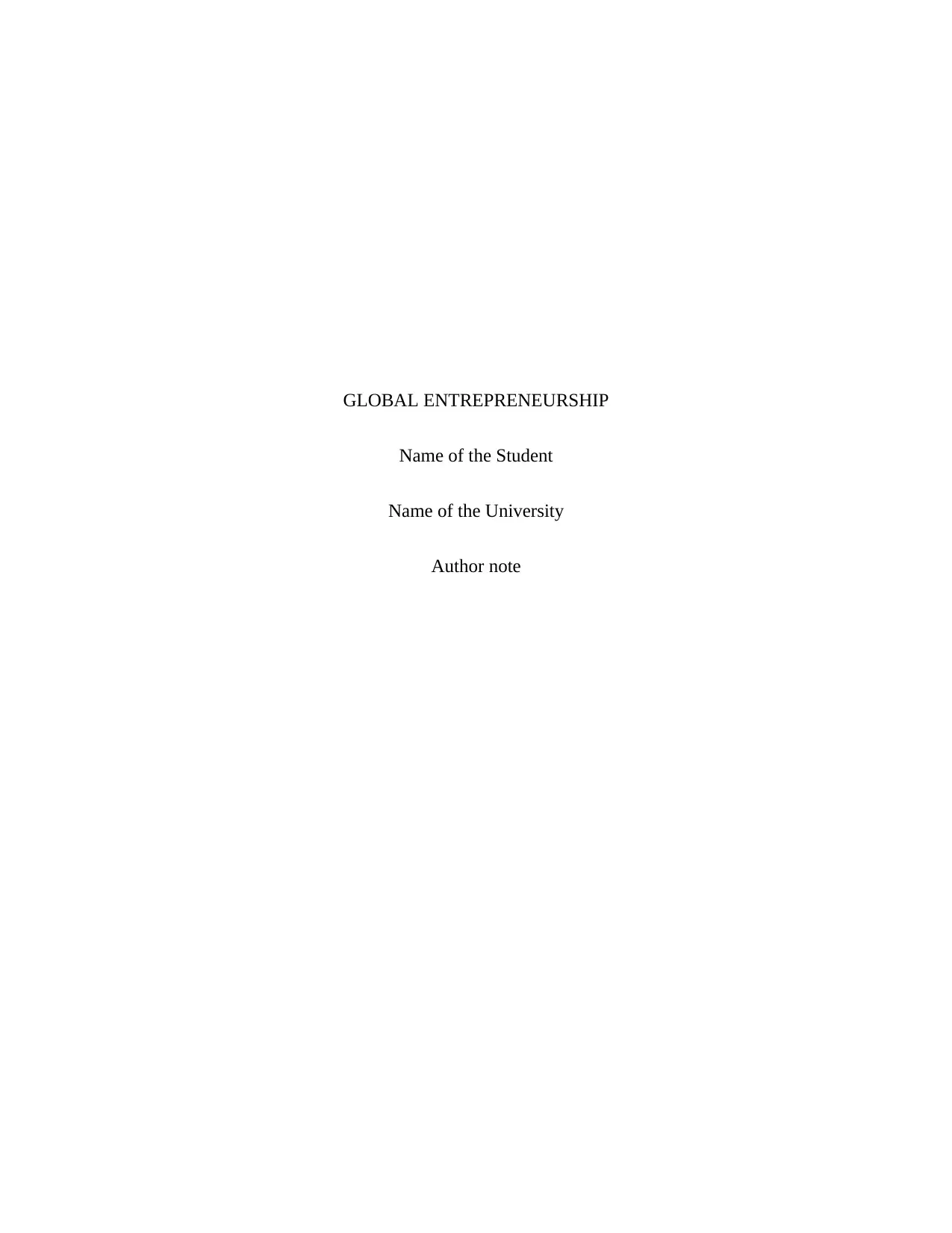
GLOBAL ENTREPRENEURSHIP
Name of the Student
Name of the University
Author note
Name of the Student
Name of the University
Author note
Paraphrase This Document
Need a fresh take? Get an instant paraphrase of this document with our AI Paraphraser
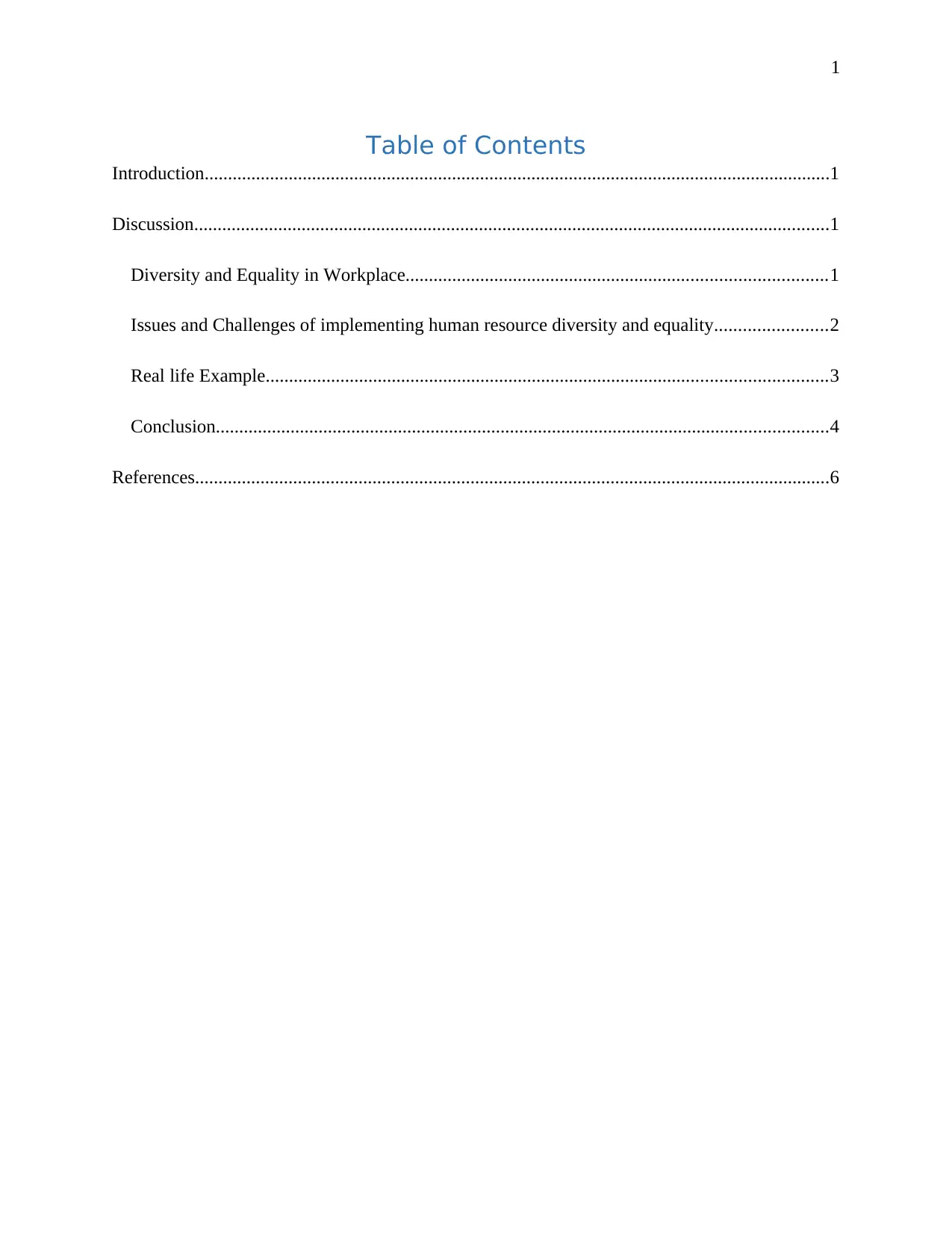
1
Table of Contents
Introduction......................................................................................................................................1
Discussion........................................................................................................................................1
Diversity and Equality in Workplace..........................................................................................1
Issues and Challenges of implementing human resource diversity and equality........................2
Real life Example........................................................................................................................3
Conclusion...................................................................................................................................4
References........................................................................................................................................6
Table of Contents
Introduction......................................................................................................................................1
Discussion........................................................................................................................................1
Diversity and Equality in Workplace..........................................................................................1
Issues and Challenges of implementing human resource diversity and equality........................2
Real life Example........................................................................................................................3
Conclusion...................................................................................................................................4
References........................................................................................................................................6
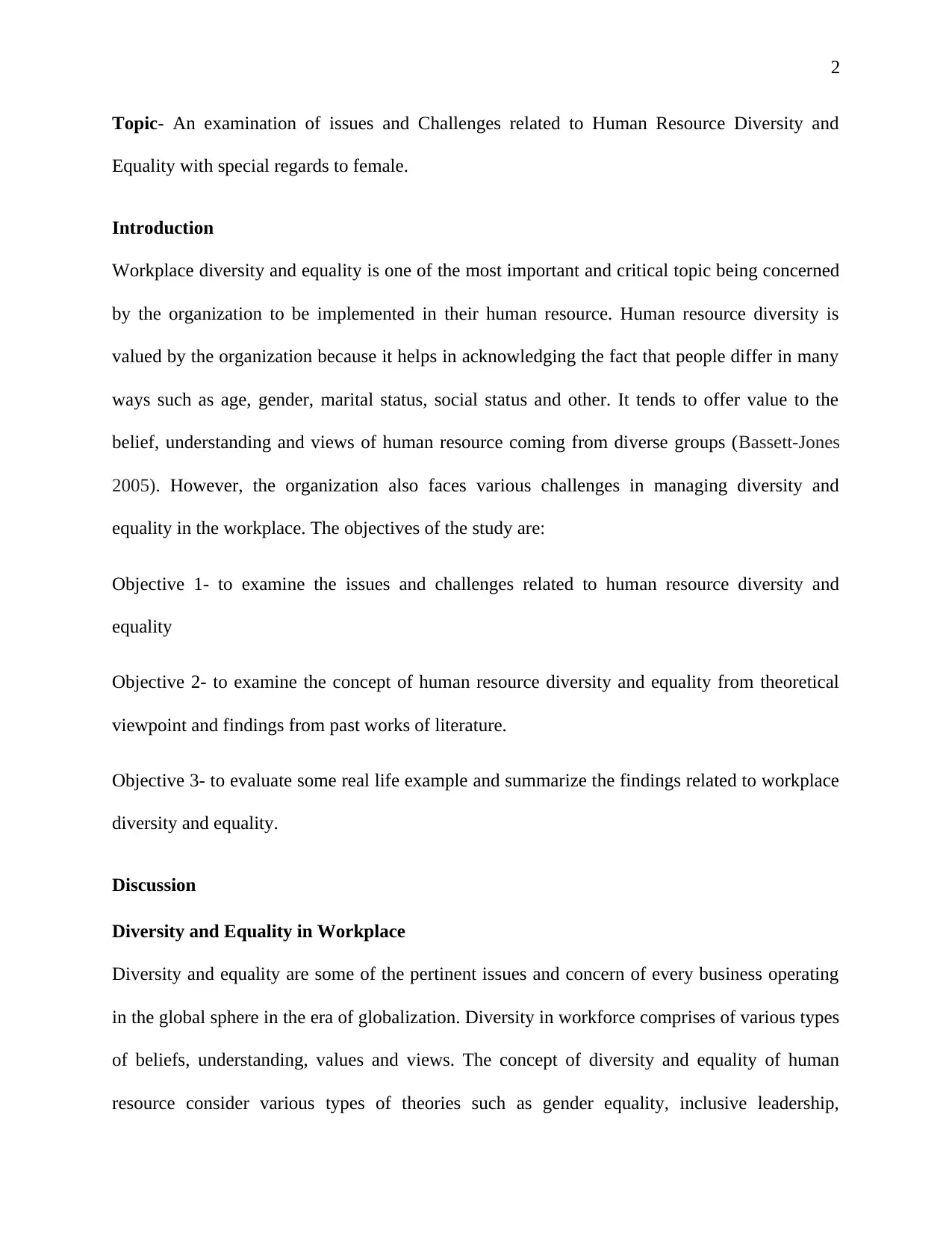
2
Topic- An examination of issues and Challenges related to Human Resource Diversity and
Equality with special regards to female.
Introduction
Workplace diversity and equality is one of the most important and critical topic being concerned
by the organization to be implemented in their human resource. Human resource diversity is
valued by the organization because it helps in acknowledging the fact that people differ in many
ways such as age, gender, marital status, social status and other. It tends to offer value to the
belief, understanding and views of human resource coming from diverse groups (Bassett‐Jones
2005). However, the organization also faces various challenges in managing diversity and
equality in the workplace. The objectives of the study are:
Objective 1- to examine the issues and challenges related to human resource diversity and
equality
Objective 2- to examine the concept of human resource diversity and equality from theoretical
viewpoint and findings from past works of literature.
Objective 3- to evaluate some real life example and summarize the findings related to workplace
diversity and equality.
Discussion
Diversity and Equality in Workplace
Diversity and equality are some of the pertinent issues and concern of every business operating
in the global sphere in the era of globalization. Diversity in workforce comprises of various types
of beliefs, understanding, values and views. The concept of diversity and equality of human
resource consider various types of theories such as gender equality, inclusive leadership,
Topic- An examination of issues and Challenges related to Human Resource Diversity and
Equality with special regards to female.
Introduction
Workplace diversity and equality is one of the most important and critical topic being concerned
by the organization to be implemented in their human resource. Human resource diversity is
valued by the organization because it helps in acknowledging the fact that people differ in many
ways such as age, gender, marital status, social status and other. It tends to offer value to the
belief, understanding and views of human resource coming from diverse groups (Bassett‐Jones
2005). However, the organization also faces various challenges in managing diversity and
equality in the workplace. The objectives of the study are:
Objective 1- to examine the issues and challenges related to human resource diversity and
equality
Objective 2- to examine the concept of human resource diversity and equality from theoretical
viewpoint and findings from past works of literature.
Objective 3- to evaluate some real life example and summarize the findings related to workplace
diversity and equality.
Discussion
Diversity and Equality in Workplace
Diversity and equality are some of the pertinent issues and concern of every business operating
in the global sphere in the era of globalization. Diversity in workforce comprises of various types
of beliefs, understanding, values and views. The concept of diversity and equality of human
resource consider various types of theories such as gender equality, inclusive leadership,
⊘ This is a preview!⊘
Do you want full access?
Subscribe today to unlock all pages.

Trusted by 1+ million students worldwide
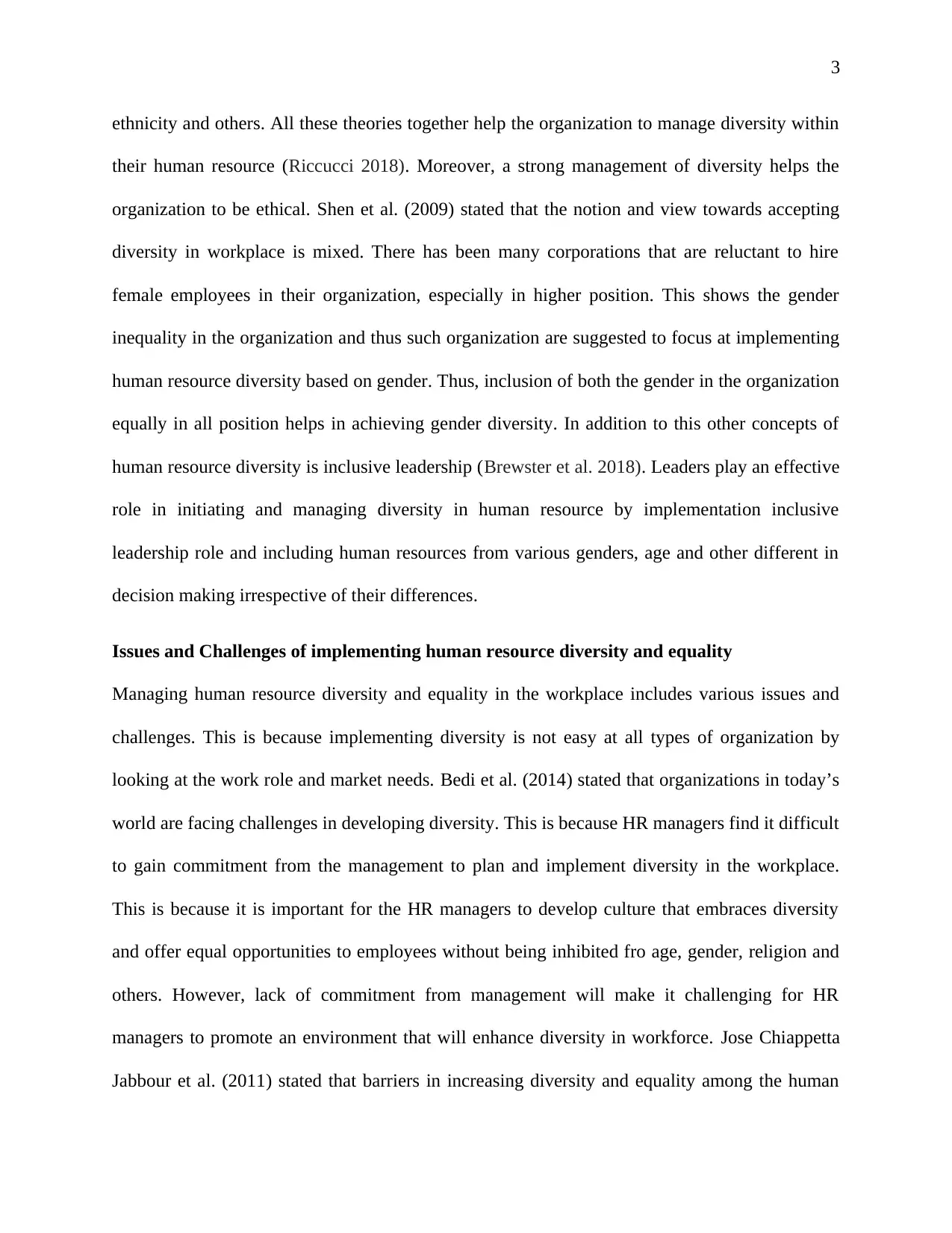
3
ethnicity and others. All these theories together help the organization to manage diversity within
their human resource (Riccucci 2018). Moreover, a strong management of diversity helps the
organization to be ethical. Shen et al. (2009) stated that the notion and view towards accepting
diversity in workplace is mixed. There has been many corporations that are reluctant to hire
female employees in their organization, especially in higher position. This shows the gender
inequality in the organization and thus such organization are suggested to focus at implementing
human resource diversity based on gender. Thus, inclusion of both the gender in the organization
equally in all position helps in achieving gender diversity. In addition to this other concepts of
human resource diversity is inclusive leadership (Brewster et al. 2018). Leaders play an effective
role in initiating and managing diversity in human resource by implementation inclusive
leadership role and including human resources from various genders, age and other different in
decision making irrespective of their differences.
Issues and Challenges of implementing human resource diversity and equality
Managing human resource diversity and equality in the workplace includes various issues and
challenges. This is because implementing diversity is not easy at all types of organization by
looking at the work role and market needs. Bedi et al. (2014) stated that organizations in today’s
world are facing challenges in developing diversity. This is because HR managers find it difficult
to gain commitment from the management to plan and implement diversity in the workplace.
This is because it is important for the HR managers to develop culture that embraces diversity
and offer equal opportunities to employees without being inhibited fro age, gender, religion and
others. However, lack of commitment from management will make it challenging for HR
managers to promote an environment that will enhance diversity in workforce. Jose Chiappetta
Jabbour et al. (2011) stated that barriers in increasing diversity and equality among the human
ethnicity and others. All these theories together help the organization to manage diversity within
their human resource (Riccucci 2018). Moreover, a strong management of diversity helps the
organization to be ethical. Shen et al. (2009) stated that the notion and view towards accepting
diversity in workplace is mixed. There has been many corporations that are reluctant to hire
female employees in their organization, especially in higher position. This shows the gender
inequality in the organization and thus such organization are suggested to focus at implementing
human resource diversity based on gender. Thus, inclusion of both the gender in the organization
equally in all position helps in achieving gender diversity. In addition to this other concepts of
human resource diversity is inclusive leadership (Brewster et al. 2018). Leaders play an effective
role in initiating and managing diversity in human resource by implementation inclusive
leadership role and including human resources from various genders, age and other different in
decision making irrespective of their differences.
Issues and Challenges of implementing human resource diversity and equality
Managing human resource diversity and equality in the workplace includes various issues and
challenges. This is because implementing diversity is not easy at all types of organization by
looking at the work role and market needs. Bedi et al. (2014) stated that organizations in today’s
world are facing challenges in developing diversity. This is because HR managers find it difficult
to gain commitment from the management to plan and implement diversity in the workplace.
This is because it is important for the HR managers to develop culture that embraces diversity
and offer equal opportunities to employees without being inhibited fro age, gender, religion and
others. However, lack of commitment from management will make it challenging for HR
managers to promote an environment that will enhance diversity in workforce. Jose Chiappetta
Jabbour et al. (2011) stated that barriers in increasing diversity and equality among the human
Paraphrase This Document
Need a fresh take? Get an instant paraphrase of this document with our AI Paraphraser
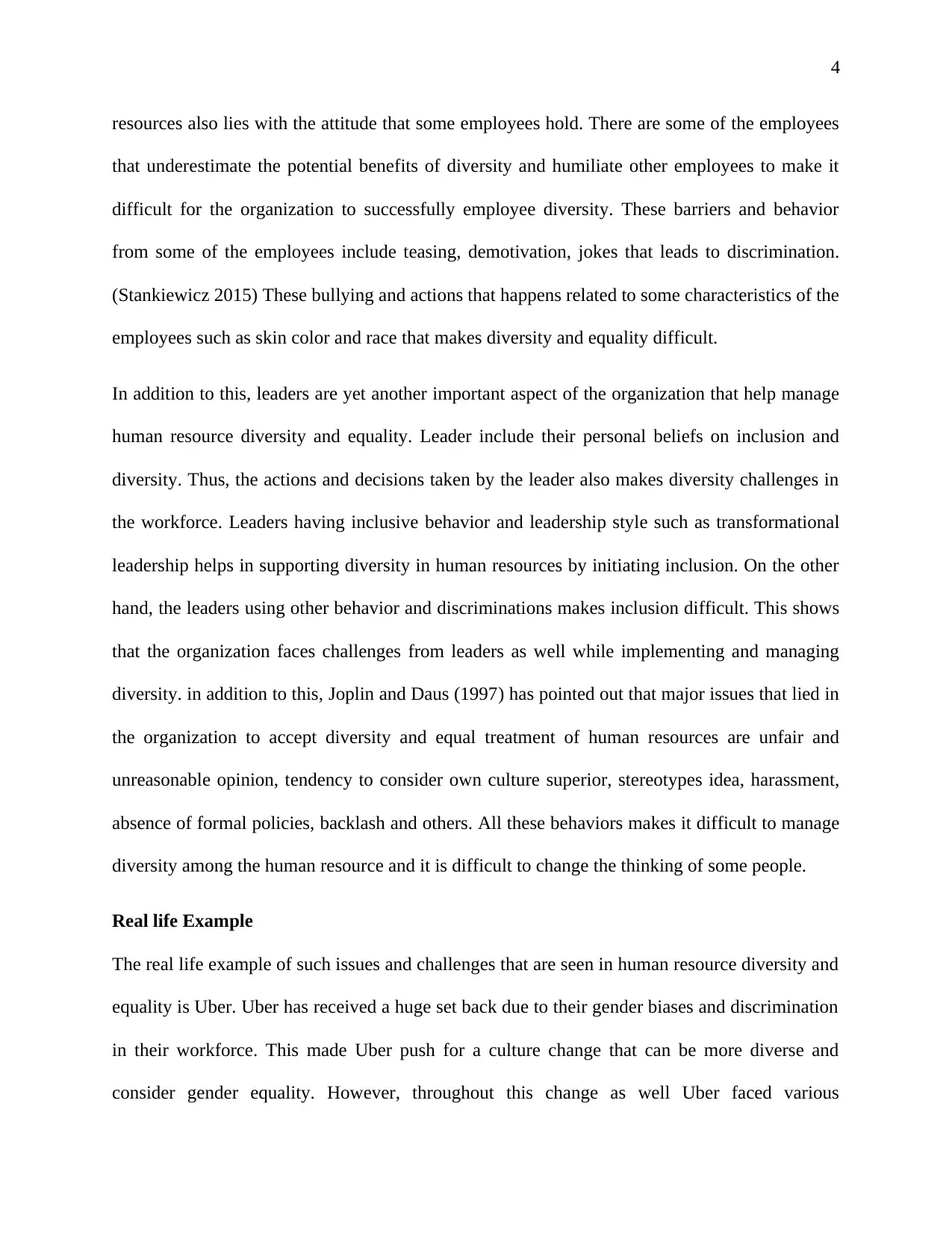
4
resources also lies with the attitude that some employees hold. There are some of the employees
that underestimate the potential benefits of diversity and humiliate other employees to make it
difficult for the organization to successfully employee diversity. These barriers and behavior
from some of the employees include teasing, demotivation, jokes that leads to discrimination.
(Stankiewicz 2015) These bullying and actions that happens related to some characteristics of the
employees such as skin color and race that makes diversity and equality difficult.
In addition to this, leaders are yet another important aspect of the organization that help manage
human resource diversity and equality. Leader include their personal beliefs on inclusion and
diversity. Thus, the actions and decisions taken by the leader also makes diversity challenges in
the workforce. Leaders having inclusive behavior and leadership style such as transformational
leadership helps in supporting diversity in human resources by initiating inclusion. On the other
hand, the leaders using other behavior and discriminations makes inclusion difficult. This shows
that the organization faces challenges from leaders as well while implementing and managing
diversity. in addition to this, Joplin and Daus (1997) has pointed out that major issues that lied in
the organization to accept diversity and equal treatment of human resources are unfair and
unreasonable opinion, tendency to consider own culture superior, stereotypes idea, harassment,
absence of formal policies, backlash and others. All these behaviors makes it difficult to manage
diversity among the human resource and it is difficult to change the thinking of some people.
Real life Example
The real life example of such issues and challenges that are seen in human resource diversity and
equality is Uber. Uber has received a huge set back due to their gender biases and discrimination
in their workforce. This made Uber push for a culture change that can be more diverse and
consider gender equality. However, throughout this change as well Uber faced various
resources also lies with the attitude that some employees hold. There are some of the employees
that underestimate the potential benefits of diversity and humiliate other employees to make it
difficult for the organization to successfully employee diversity. These barriers and behavior
from some of the employees include teasing, demotivation, jokes that leads to discrimination.
(Stankiewicz 2015) These bullying and actions that happens related to some characteristics of the
employees such as skin color and race that makes diversity and equality difficult.
In addition to this, leaders are yet another important aspect of the organization that help manage
human resource diversity and equality. Leader include their personal beliefs on inclusion and
diversity. Thus, the actions and decisions taken by the leader also makes diversity challenges in
the workforce. Leaders having inclusive behavior and leadership style such as transformational
leadership helps in supporting diversity in human resources by initiating inclusion. On the other
hand, the leaders using other behavior and discriminations makes inclusion difficult. This shows
that the organization faces challenges from leaders as well while implementing and managing
diversity. in addition to this, Joplin and Daus (1997) has pointed out that major issues that lied in
the organization to accept diversity and equal treatment of human resources are unfair and
unreasonable opinion, tendency to consider own culture superior, stereotypes idea, harassment,
absence of formal policies, backlash and others. All these behaviors makes it difficult to manage
diversity among the human resource and it is difficult to change the thinking of some people.
Real life Example
The real life example of such issues and challenges that are seen in human resource diversity and
equality is Uber. Uber has received a huge set back due to their gender biases and discrimination
in their workforce. This made Uber push for a culture change that can be more diverse and
consider gender equality. However, throughout this change as well Uber faced various
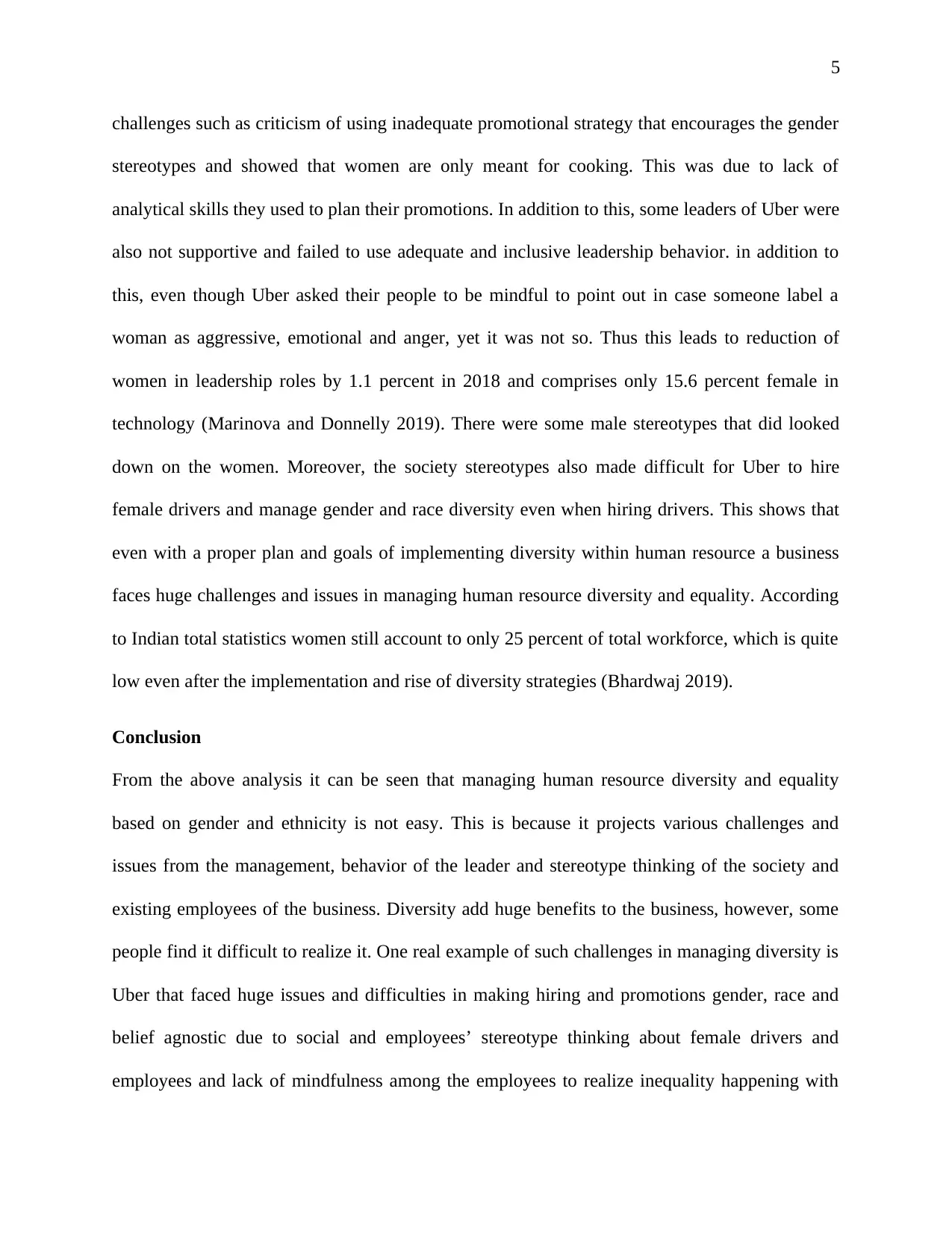
5
challenges such as criticism of using inadequate promotional strategy that encourages the gender
stereotypes and showed that women are only meant for cooking. This was due to lack of
analytical skills they used to plan their promotions. In addition to this, some leaders of Uber were
also not supportive and failed to use adequate and inclusive leadership behavior. in addition to
this, even though Uber asked their people to be mindful to point out in case someone label a
woman as aggressive, emotional and anger, yet it was not so. Thus this leads to reduction of
women in leadership roles by 1.1 percent in 2018 and comprises only 15.6 percent female in
technology (Marinova and Donnelly 2019). There were some male stereotypes that did looked
down on the women. Moreover, the society stereotypes also made difficult for Uber to hire
female drivers and manage gender and race diversity even when hiring drivers. This shows that
even with a proper plan and goals of implementing diversity within human resource a business
faces huge challenges and issues in managing human resource diversity and equality. According
to Indian total statistics women still account to only 25 percent of total workforce, which is quite
low even after the implementation and rise of diversity strategies (Bhardwaj 2019).
Conclusion
From the above analysis it can be seen that managing human resource diversity and equality
based on gender and ethnicity is not easy. This is because it projects various challenges and
issues from the management, behavior of the leader and stereotype thinking of the society and
existing employees of the business. Diversity add huge benefits to the business, however, some
people find it difficult to realize it. One real example of such challenges in managing diversity is
Uber that faced huge issues and difficulties in making hiring and promotions gender, race and
belief agnostic due to social and employees’ stereotype thinking about female drivers and
employees and lack of mindfulness among the employees to realize inequality happening with
challenges such as criticism of using inadequate promotional strategy that encourages the gender
stereotypes and showed that women are only meant for cooking. This was due to lack of
analytical skills they used to plan their promotions. In addition to this, some leaders of Uber were
also not supportive and failed to use adequate and inclusive leadership behavior. in addition to
this, even though Uber asked their people to be mindful to point out in case someone label a
woman as aggressive, emotional and anger, yet it was not so. Thus this leads to reduction of
women in leadership roles by 1.1 percent in 2018 and comprises only 15.6 percent female in
technology (Marinova and Donnelly 2019). There were some male stereotypes that did looked
down on the women. Moreover, the society stereotypes also made difficult for Uber to hire
female drivers and manage gender and race diversity even when hiring drivers. This shows that
even with a proper plan and goals of implementing diversity within human resource a business
faces huge challenges and issues in managing human resource diversity and equality. According
to Indian total statistics women still account to only 25 percent of total workforce, which is quite
low even after the implementation and rise of diversity strategies (Bhardwaj 2019).
Conclusion
From the above analysis it can be seen that managing human resource diversity and equality
based on gender and ethnicity is not easy. This is because it projects various challenges and
issues from the management, behavior of the leader and stereotype thinking of the society and
existing employees of the business. Diversity add huge benefits to the business, however, some
people find it difficult to realize it. One real example of such challenges in managing diversity is
Uber that faced huge issues and difficulties in making hiring and promotions gender, race and
belief agnostic due to social and employees’ stereotype thinking about female drivers and
employees and lack of mindfulness among the employees to realize inequality happening with
⊘ This is a preview!⊘
Do you want full access?
Subscribe today to unlock all pages.

Trusted by 1+ million students worldwide
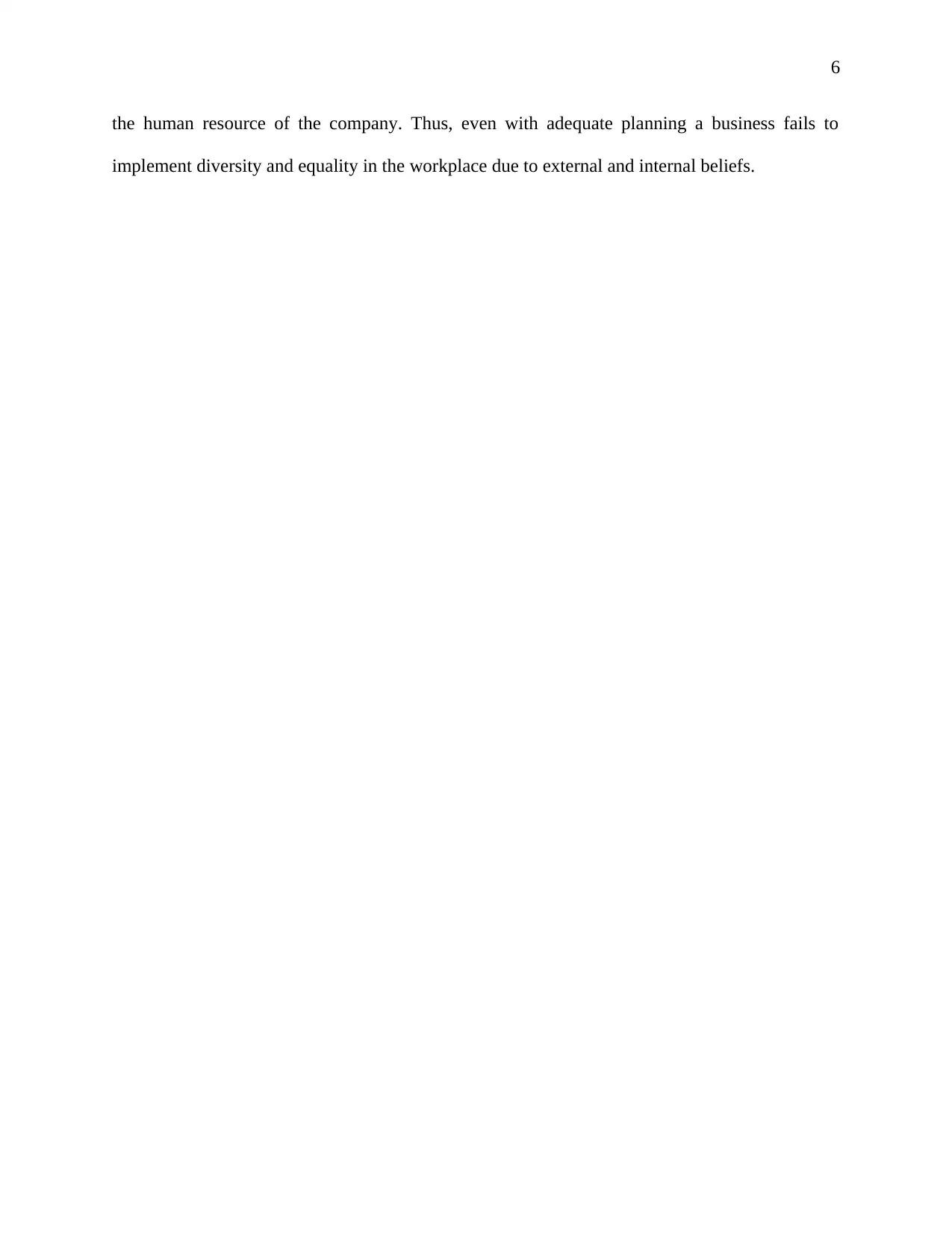
6
the human resource of the company. Thus, even with adequate planning a business fails to
implement diversity and equality in the workplace due to external and internal beliefs.
the human resource of the company. Thus, even with adequate planning a business fails to
implement diversity and equality in the workplace due to external and internal beliefs.
Paraphrase This Document
Need a fresh take? Get an instant paraphrase of this document with our AI Paraphraser
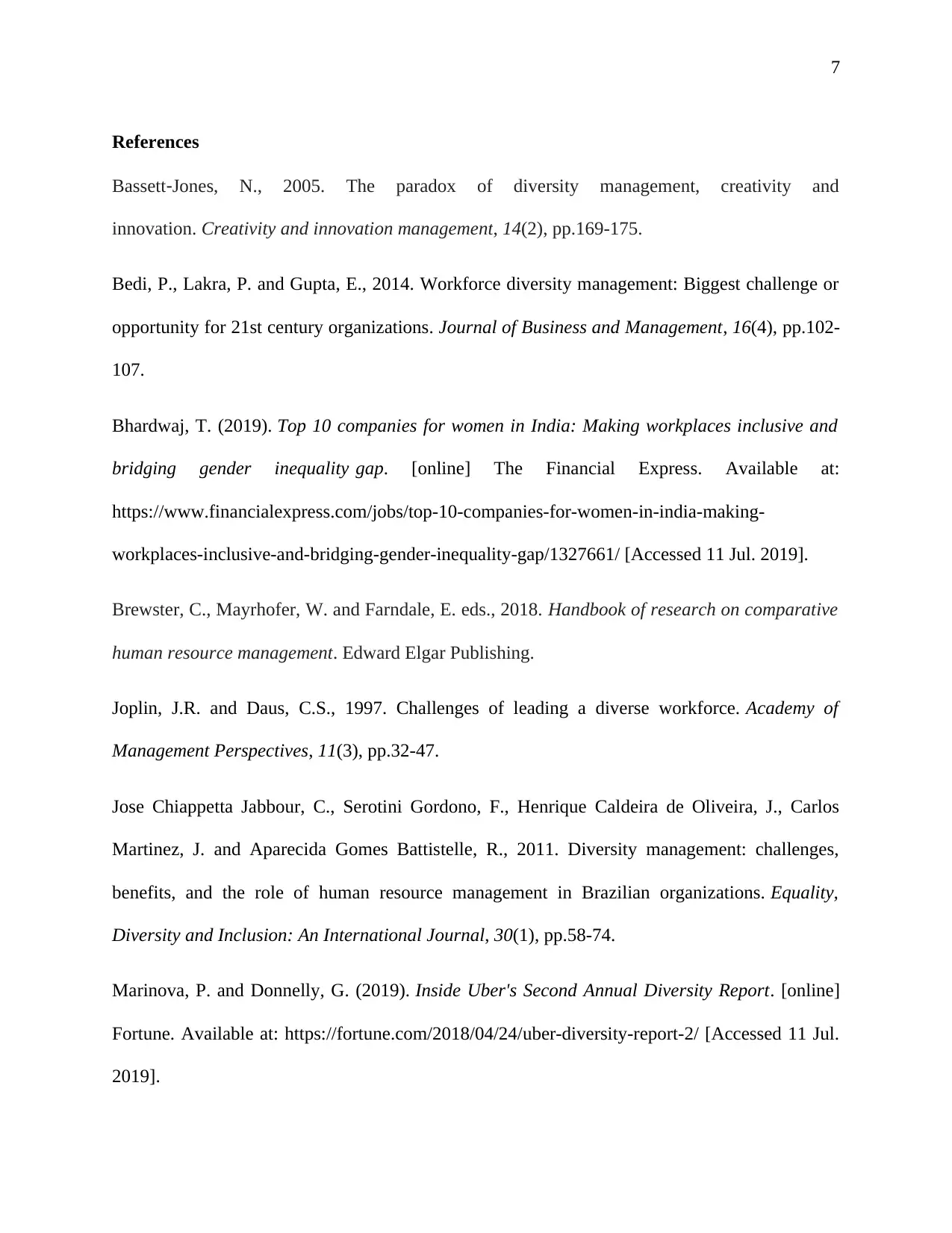
7
References
Bassett‐Jones, N., 2005. The paradox of diversity management, creativity and
innovation. Creativity and innovation management, 14(2), pp.169-175.
Bedi, P., Lakra, P. and Gupta, E., 2014. Workforce diversity management: Biggest challenge or
opportunity for 21st century organizations. Journal of Business and Management, 16(4), pp.102-
107.
Bhardwaj, T. (2019). Top 10 companies for women in India: Making workplaces inclusive and
bridging gender inequality gap. [online] The Financial Express. Available at:
https://www.financialexpress.com/jobs/top-10-companies-for-women-in-india-making-
workplaces-inclusive-and-bridging-gender-inequality-gap/1327661/ [Accessed 11 Jul. 2019].
Brewster, C., Mayrhofer, W. and Farndale, E. eds., 2018. Handbook of research on comparative
human resource management. Edward Elgar Publishing.
Joplin, J.R. and Daus, C.S., 1997. Challenges of leading a diverse workforce. Academy of
Management Perspectives, 11(3), pp.32-47.
Jose Chiappetta Jabbour, C., Serotini Gordono, F., Henrique Caldeira de Oliveira, J., Carlos
Martinez, J. and Aparecida Gomes Battistelle, R., 2011. Diversity management: challenges,
benefits, and the role of human resource management in Brazilian organizations. Equality,
Diversity and Inclusion: An International Journal, 30(1), pp.58-74.
Marinova, P. and Donnelly, G. (2019). Inside Uber's Second Annual Diversity Report. [online]
Fortune. Available at: https://fortune.com/2018/04/24/uber-diversity-report-2/ [Accessed 11 Jul.
2019].
References
Bassett‐Jones, N., 2005. The paradox of diversity management, creativity and
innovation. Creativity and innovation management, 14(2), pp.169-175.
Bedi, P., Lakra, P. and Gupta, E., 2014. Workforce diversity management: Biggest challenge or
opportunity for 21st century organizations. Journal of Business and Management, 16(4), pp.102-
107.
Bhardwaj, T. (2019). Top 10 companies for women in India: Making workplaces inclusive and
bridging gender inequality gap. [online] The Financial Express. Available at:
https://www.financialexpress.com/jobs/top-10-companies-for-women-in-india-making-
workplaces-inclusive-and-bridging-gender-inequality-gap/1327661/ [Accessed 11 Jul. 2019].
Brewster, C., Mayrhofer, W. and Farndale, E. eds., 2018. Handbook of research on comparative
human resource management. Edward Elgar Publishing.
Joplin, J.R. and Daus, C.S., 1997. Challenges of leading a diverse workforce. Academy of
Management Perspectives, 11(3), pp.32-47.
Jose Chiappetta Jabbour, C., Serotini Gordono, F., Henrique Caldeira de Oliveira, J., Carlos
Martinez, J. and Aparecida Gomes Battistelle, R., 2011. Diversity management: challenges,
benefits, and the role of human resource management in Brazilian organizations. Equality,
Diversity and Inclusion: An International Journal, 30(1), pp.58-74.
Marinova, P. and Donnelly, G. (2019). Inside Uber's Second Annual Diversity Report. [online]
Fortune. Available at: https://fortune.com/2018/04/24/uber-diversity-report-2/ [Accessed 11 Jul.
2019].
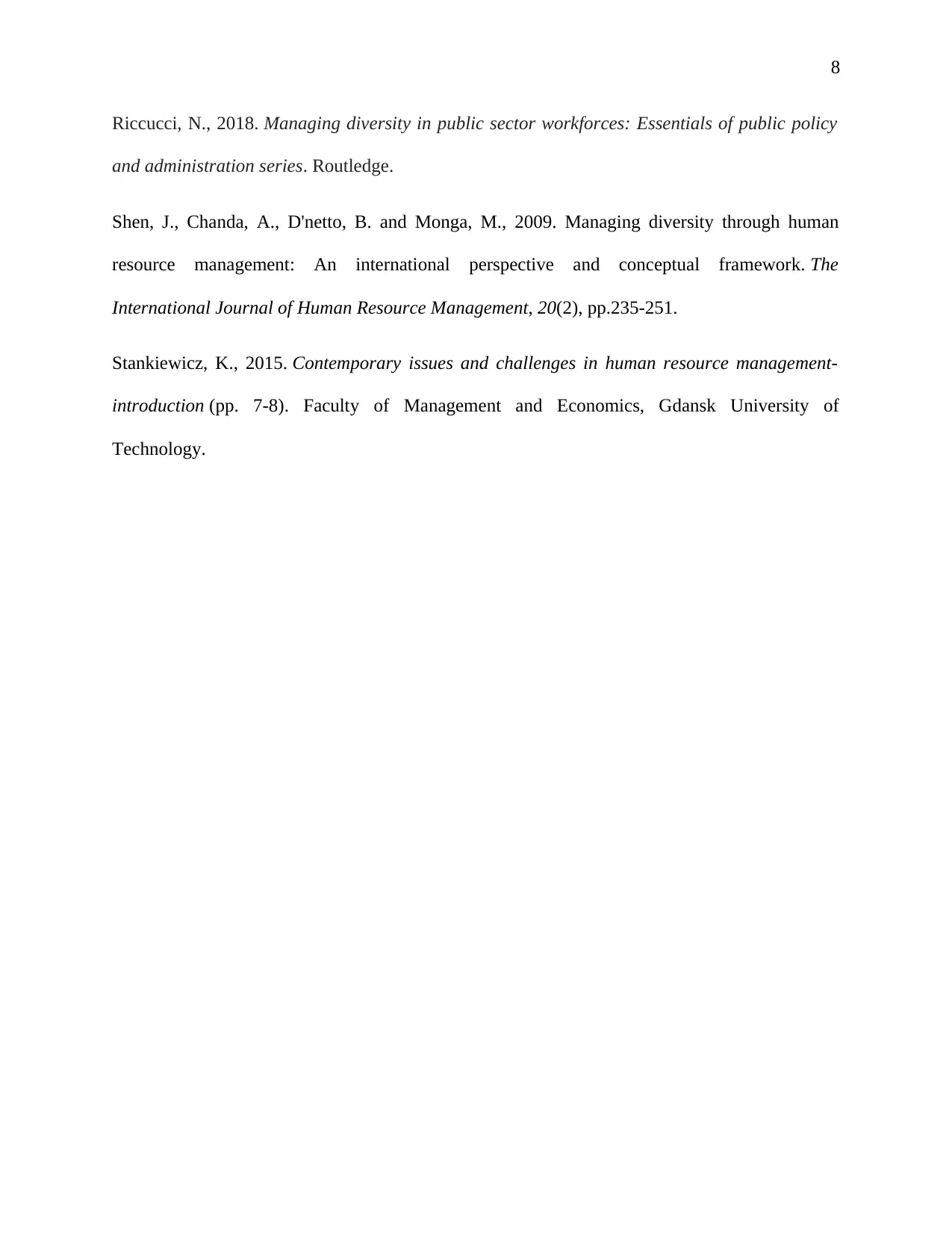
8
Riccucci, N., 2018. Managing diversity in public sector workforces: Essentials of public policy
and administration series. Routledge.
Shen, J., Chanda, A., D'netto, B. and Monga, M., 2009. Managing diversity through human
resource management: An international perspective and conceptual framework. The
International Journal of Human Resource Management, 20(2), pp.235-251.
Stankiewicz, K., 2015. Contemporary issues and challenges in human resource management-
introduction (pp. 7-8). Faculty of Management and Economics, Gdansk University of
Technology.
Riccucci, N., 2018. Managing diversity in public sector workforces: Essentials of public policy
and administration series. Routledge.
Shen, J., Chanda, A., D'netto, B. and Monga, M., 2009. Managing diversity through human
resource management: An international perspective and conceptual framework. The
International Journal of Human Resource Management, 20(2), pp.235-251.
Stankiewicz, K., 2015. Contemporary issues and challenges in human resource management-
introduction (pp. 7-8). Faculty of Management and Economics, Gdansk University of
Technology.
⊘ This is a preview!⊘
Do you want full access?
Subscribe today to unlock all pages.

Trusted by 1+ million students worldwide
1 out of 9
Related Documents
Your All-in-One AI-Powered Toolkit for Academic Success.
+13062052269
info@desklib.com
Available 24*7 on WhatsApp / Email
![[object Object]](/_next/static/media/star-bottom.7253800d.svg)
Unlock your academic potential
Copyright © 2020–2025 A2Z Services. All Rights Reserved. Developed and managed by ZUCOL.





